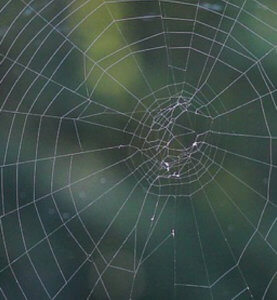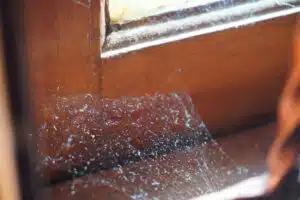Identifying the Different Types of Spider Webs
By: Rita Stadler
Spiders are remarkable creatures that have fascinated scientists and nature enthusiasts for centuries. One of their most intriguing features is their ability to create intricate webs. These webs play a significant role in nature, particularly in capturing flying insects. Understanding the various types of spider webs is crucial for both pest control and spider management. In this article, we will delve into the world of spider webs, their types, and the importance of identifying them.
Significance of Spider Webs in Nature
Before we explore the different types of spider webs, let’s delve into spider anatomy and the fascinating process of web building.
Spiders belong to the class Arachnida, a group of joint-legged invertebrates that also includes scorpions, ticks, and mites. Arachnids are characterized by their two main body parts: the cephalothorax and the abdomen.
Spinnerets are specialized structures located at the rear end of a spider’s abdomen. These tiny organs produce silk, the material from which webs are constructed. Spider silk is incredibly strong and flexible, making it a versatile tool for various purposes. In addition to the importance of silk for the spiders, it may have other practical and medicinal uses for people, too!
Different Types of Spider Webs
Spiders produce different types of silk for different purposes, such as building webs, creating egg sacs, or constructing retreats. Each type of silk has unique properties tailored to its specific function. Let’s explore the main types of spider webs crafted with this silk.
- Orb Webs: Orb webs are the classic spider webs that most people envision. They are known for their radial design and are built by orb-weaver spiders (Araneidae). These webs are intricate and highly effective at capturing flying insects. Orb webs consist of a wheel-like spoke design, featuring a radial framework with a sticky, spiral-shaped capture spiral. The spiral is strategically placed to intercept and ensnare prey. While many orb-weaver spiders are venomous, most are harmless to humans and only pose a threat to their insect prey.
- Sheet Webs and Hammocks: Sheet webs are different from orb webs and are constructed by spiders of the Linyphiidae family. They have a unique flat, horizontal structure. Some sheet webs take on a hammock-like shape and are used to catch prey that lands on them. These webs are an excellent example of nature’s engineering. Triangle webs are another variation of sheet webs. They are characterized by a triangular shape and are used by certain spider species for capturing prey. Most spiders in the Linyphiidae family, including money spiders, are not venomous enough to harm humans.
- Funnel Webs: These webs are constructed by spiders of the Agelenidae family, such as the hobo spider and grass spider. These webs have a tubular entrance, and the spider waits inside for prey to come close. Funnel webs are strategically positioned to intercept insects on the ground or in low vegetation. The spider’s position inside the tube allows for a surprise attack. Some Agelenidae spiders can deliver venomous bites, but their bites are rarely dangerous to humans.
Cobwebs or Tangle Webs: Cobwebs, also known as tangle webs, are perhaps the most recognizable webs. They are constructed by spiders of the Theridiidae family (commonly known as comb-footed spiders) and the Dictynidae family. Cobwebs are messy and irregular in shape, with sticky threads that entangle prey. They are often found in corners, crevices, and abandoned structures. While some Theridiidae spiders, such as the black widow, are venomous and can pose a risk to humans, most cobweb spiders are harmless.
In addition to these main types of webs, spiders exhibit a wide range of other unique web designs. Horizontal webs, for example, are constructed by certain spider families and have distinct features. Common house spiders, like the infamous cellar spider and cobweb spider, each have distinctive web patterns that can be identified with careful observation.
Webless Spiders
Not all spiders rely on webs for hunting. Some species of spiders, like jumping spiders and wolf spiders, are skilled hunters who rely on speed and agility to catch their prey. They are ground dwellers and do not construct traditional webs.
Web Identification and Spider Families
Identifying spider webs is a valuable skill, especially for those who want to manage spider populations in and around their homes. Web characteristics and the presence of egg sacs can be vital clues for identifying specific species. Egg sacs, which contain spider eggs, are often associated with a particular species. Examining these sacs can help determine which type of spider has made a home nearby
The structure and location of a web can also provide valuable information about the species responsible. Observing the spider’s behavior around the web can aid in identification as well..
Keeping Spiders (and Their Webs) Out of Your Home
While spiders are beneficial in many ways, some people prefer to keep them out of their homes. Understanding the types of spiders and webs you have in your home can guide you in effective pest control.
To prevent spiders from entering your living space, consider using botanical deterrents like the Stay Away® Spiders product by EarthKind, which utilizes botanical ingredients for spider control while respecting their role in ecosystems.
In conclusion, spider webs are not just architectural marvels; they are essential tools for survival and play a crucial role in maintaining ecological balance. By understanding the different types of webs and their builders, we can appreciate the intricate designs of nature and coexist peacefully with these fascinating arachnids.
Shop Stay Away® Spiders online or in a store near you.






 Cobwebs or Tangle Webs: Cobwebs, also known as tangle webs, are perhaps the most recognizable webs. They are constructed by spiders of the Theridiidae family (commonly known as comb-footed spiders) and the Dictynidae family. Cobwebs are messy and irregular in shape, with sticky threads that entangle prey. They are often found in corners, crevices, and abandoned structures. While some Theridiidae spiders, such as the
Cobwebs or Tangle Webs: Cobwebs, also known as tangle webs, are perhaps the most recognizable webs. They are constructed by spiders of the Theridiidae family (commonly known as comb-footed spiders) and the Dictynidae family. Cobwebs are messy and irregular in shape, with sticky threads that entangle prey. They are often found in corners, crevices, and abandoned structures. While some Theridiidae spiders, such as the 

 day
day